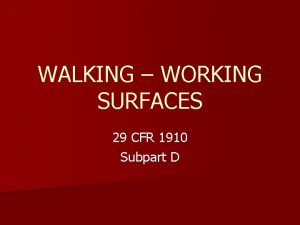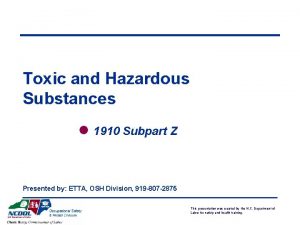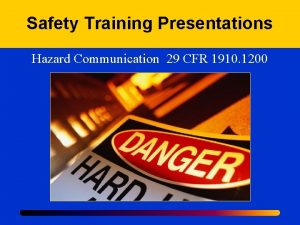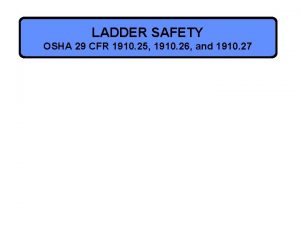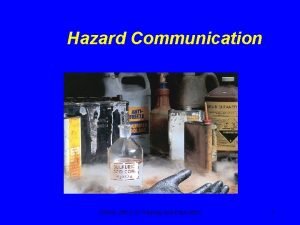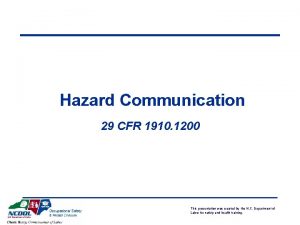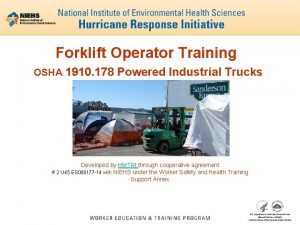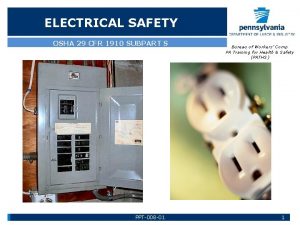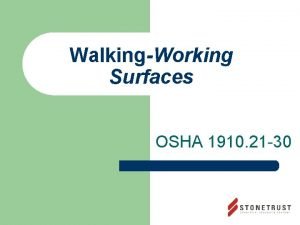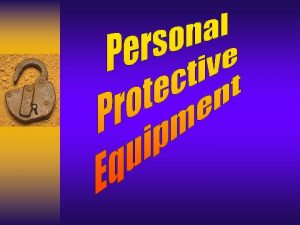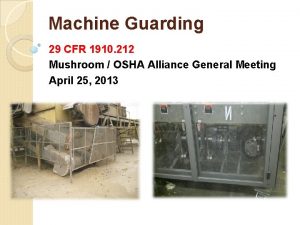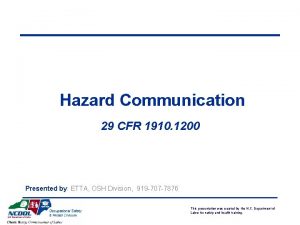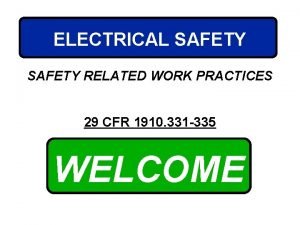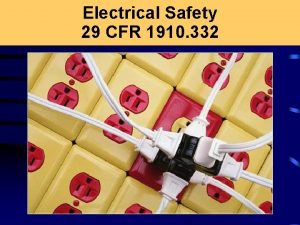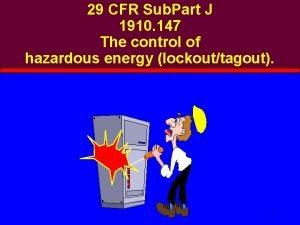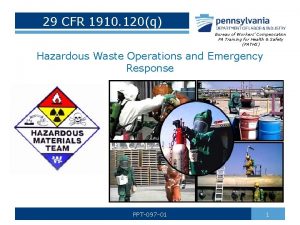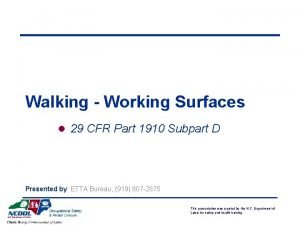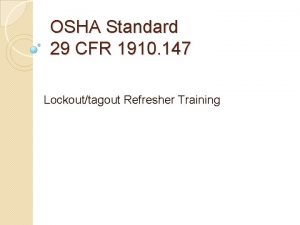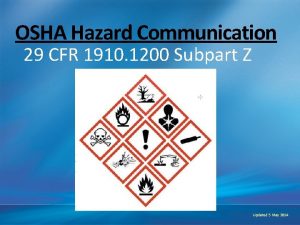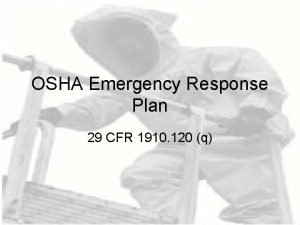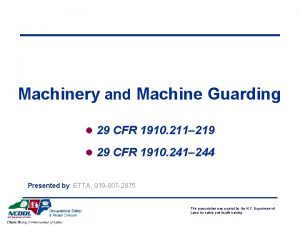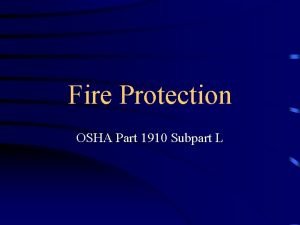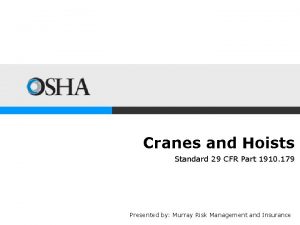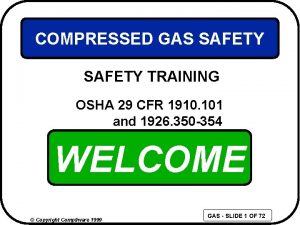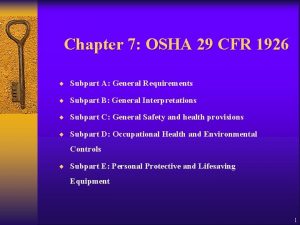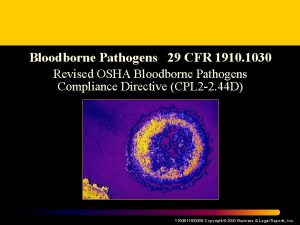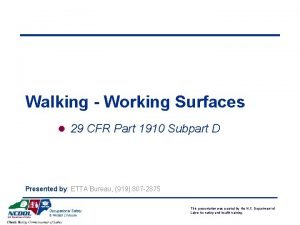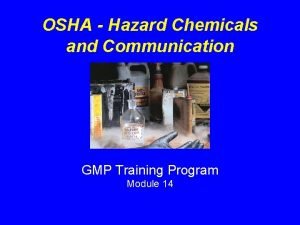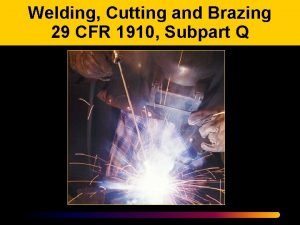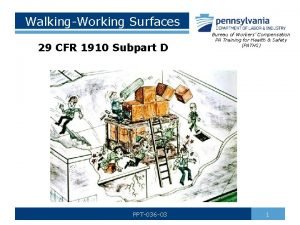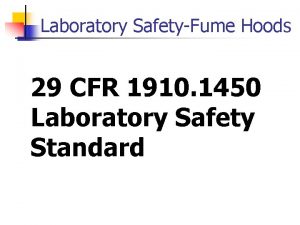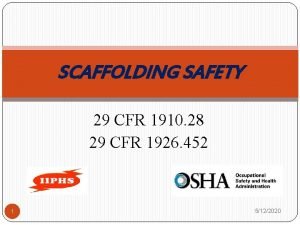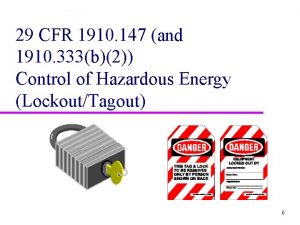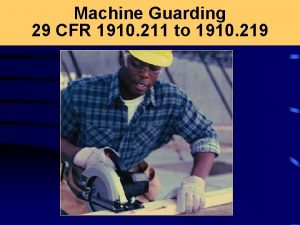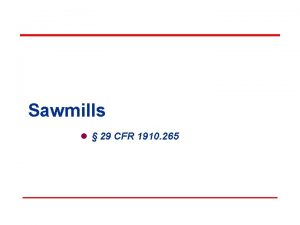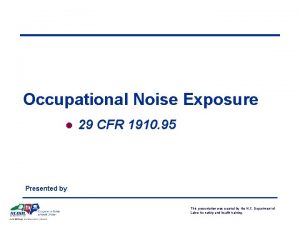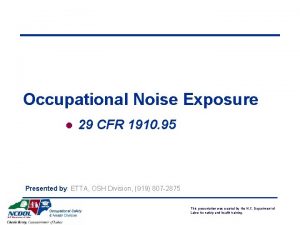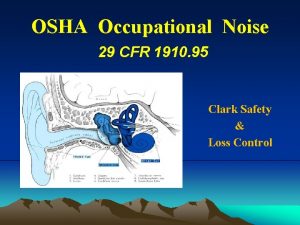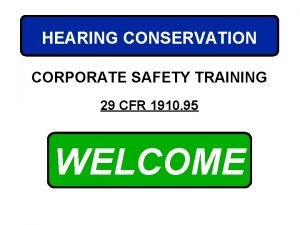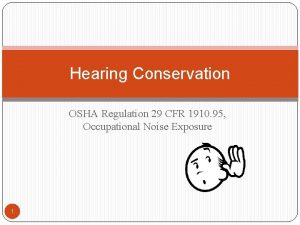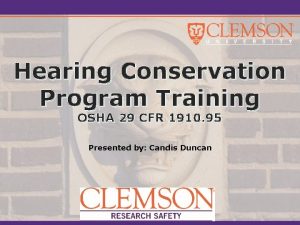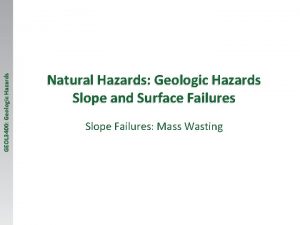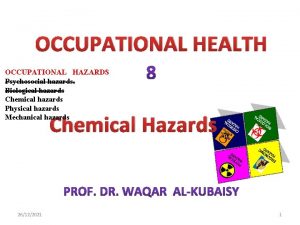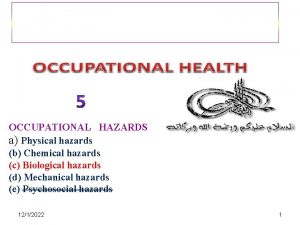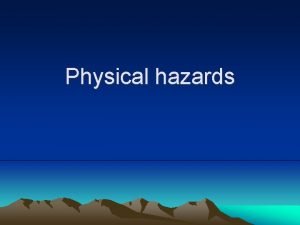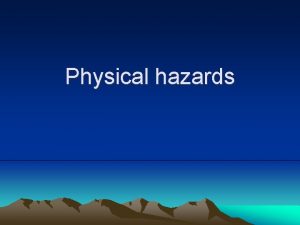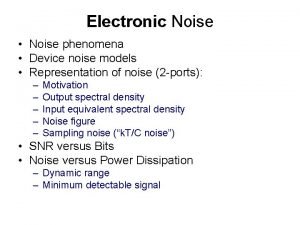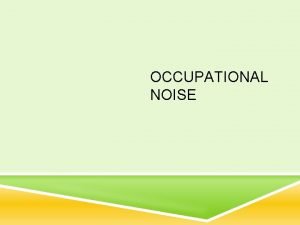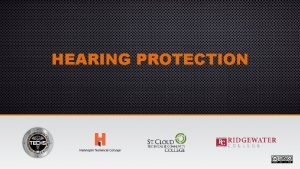Chapter Ten Hearing Noise Hazards 29 CFR 1910







































- Slides: 39

Chapter Ten Hearing & Noise Hazards 29 CFR 1910. 95 1

Objectives What is sound? What is noise? How the ear works How to measure noise OSHA noise requirements Hearing Protection 2

What is Sound? Vibrations transmitted through an elastic solid or a liquid or gas Transmitted vibrations of any frequency The sensation stimulated in the organs of hearing by such vibrations in the air or other medium A distinctive noise The distance over which something can be heard 3

What is Sound? How do we measure sound? Hertz (Hz) – Unit of frequency, equal to one cycle per second – The frequency of electrical vibrations (cycles) per second – A high or low pitch Decibel (d. B) – Unit to measure the magnitude or intensity of sound The loudness of the sound 4

What is Sound? Frequency The number of cycles or events per unit time The response of the human ear to sound is dependent on the frequency of the sound 5

What is Sound? Frequency The range of human hearing is from 20 Hz to roughly 20 k. Hz – You can hear different frequencies better than others The human ear has peak response around 2, 500 to 3, 000 Hz and has a relatively low response at low frequencies – With increasing age, the upper frequency limit tends to decrease Frequencies around 2, 000 Hz are the most important for understanding speech, while frequencies between 3, 000 Hz and 4, 000 Hz are the earliest to be affected by noise 6

What is Sound? Frequency - number of waves that happen over time Wave Frequency 7

What is Sound? Decibels The quietest sound most humans can detect is 0 d. B Some humans can even hear sounds as quiet as -5 d. B Smallest difference in the level of sound the human ear can perceive – Human ear is sensitive to a wide range of sound – More sensitive to frequencies in the upper range 8

Sensorineural Hearing Loss Sensorineural hearing loss: – occurs when there is damage to the inner ear (cochlea) or to the nerve pathways from the inner ear (retro-cochlear) to the brain – cannot be medically or surgically corrected. It is a permanent loss – not only involves a reduction in sound level, or ability to hear faint sounds, but also affects speech understanding, or ability to hear clearly – can be caused by diseases, birth injury, drugs that are toxic to the auditory system, and genetic syndromes – may also occur as a result of noise exposure, viruses, head trauma, aging, and tumors 9

Noise and Hearing Protection Can Noise Really Hurt My Ears? FACT One in ten Americans has a hearing loss that affects his or her ability to understand normal speech. Individuals with hearing loss constitute the single largest disability group in America. Excessive noise exposure is the most common cause of hearing loss. Noise is measured by Intensity (loudness) and Frequency (Pitch) Yes, noise can damage to your hearing if it is loud enough and how long you are exposed to it without protection

What is Noise? Unwanted Sound – a sound that is loud, unpleasant, unexpected, or undesired Loudness: The magnitude of the physiological sensation produced by a sound, which varies directly with the physical intensity of sound but also depends on frequency of sound and waveform 11

What is Noise? 12

What is Noise? Effects of Noise What kinds of health effects can be caused by exposure to noise? – The two kinds of health effects of noise are non-auditory effects and auditory effects Non-auditory effects include stress, related physiological and behavioral effects, and safety concerns Auditory effects include hearing impairment resulting from excessive noise exposure. Noiseinduced permanent hearing loss is the main concern related to occupational noise exposure 13

What is Noise? Effects of Noise Psychological effects – Startle – Annoy – Disrupt concentration, sleep or relaxation Interference with speech communication Physiological effects – – – – Hearing loss Aural (ear) pain Increase in stress High blood pressure Ulcers Headaches Sleeping disorders 14 Noise. Monoprint

How do we hear? 1) Your outer ear collects sound waves and channels them down the ear canal to a thin, tight piece of skin – tympanic membrane (ear drum) 2) The eardrum vibrates in response to these pressure waves and pushes on the small bones of your middle ear. These bones act like a set of levers, transferring their mechanical motion to a fluid -filled structure in the inner ear, called the cochlea 3) In the cochlea, cells with tiny sensing hairs transform the fluid movement into electrical signals. These signals travel along the auditory nerve to your brain. Once in the brain, the nerve signals are decoded and processed into what we recognize as sound

Figure 15. The left panel shows normal stereocilia (or hair bundles) associated with inner hair cells in the cochlea. The middle and right panels show noise-induced damage to hair cells. Note the bent-over stereocilia 16

How the Ear Works The Ear Does Something Else Too! The semi-circular canals – Three tubes laying perpendicular to one another – Filled with fluid and tiny hair cells – Depending on which way your head is tilted, the fluid moves the hair cells, an they send a signal to your brain Responsible for balance 17

Common Sounds & d. B Levels Sound Loudness (d. B) Near total silence 0 Whispering 15 Normal conversation OSHA level for required hearing protection Lawnmower 60 85 Rock concert 120 90

Hearing Protection

Hearing Protection When it’s not feasible to reduce the noise or its duration – use ear protective devices Ear protective devices must be fitted

How to Measure Noise How do you determine noise levels Sound level meter – Determine the loudness (d. B) of noise at any given moment – Types of decibel measurement: d. B, d. BA, d. BC, d. BV, d. Bm and d. Bi 10/1/99 Personal Dosimeters – Worn by employees – Measures the average loudness in an 8 hour work shift “ 8 hr. TWA” (Time Weighted Average) – Can also measure noise dose 21

Noise and Hearing Protection Hearing protection must be provided when noise exceeds an 8 hour time-weighted average of 85 dba Do you know how much noise you are exposed to in your work site and what is the common method used to make this determination? Inlet Scrubber- 97 DBA Area Surveys

Noise and Hearing Protection 50’ From Fan Coolers- 87 DBA

Noise and Hearing Protection 3606 Unit -102 -104 DBA

What does OSHA Say? At 85 d. B (8 hour TWA) At 90 d. B or more (50% Dose) (100% Dose) – Train employees – Make hearing protection available – Sample for noise levels – Do hearing tests – Notify employees of results – OSHA gets mad – We must keep levels at or below 90 d. B – Or require hearing protection that will lower noise levels to to 90 d. B 25

What does OSHA Say? Hearing Loss Impact - One loud bang Cumulative - Years of a noisy environment Tinnitus - Ringing in the ears Presbycusis - Hearing loss due to aging 10/1/99 26

Other Causes of Hearing Loss Measles/Otosclerosis Aging Head injury Drugs/Medicine Chemicals Heredity

What does OSHA Say? Interpreting Hearing Tests Hearing Protection Hearing Conservation Program Testing Training Engineering Controls – Any use of engineering methods to reduce or control the sound level of a noise source by modifying or replacing equipment, making any physical changes at the noise source or along the transmission path (with the exception of hearing protectors) Administrative Controls – Efforts, usually by management, to limit workers' noise exposure by modifying workers' schedule or location, or by modifying the operating schedule of noisy machinery Hearing Protection 28

Hearing Protection Engineering Controls Replace worn or loose machine parts Replace noisy materials with quieter ones Maintain and lubricate equipment Consider noise levels of new machinery and during renovations 29

Hearing Protection Engineering Controls Place noisy machinery in isolated area Place heavy machinery on rubber mountings to reduce vibration Use sound absorbing acoustical tiles and/or blankets on floors, walls, and ceilings Keep guards and enclosures securely attached to machinery Use mufflers on exhausts to machinery Repair compressed air leaks 30

Hearing Protection Administrative Controls Arrange work schedules to cut down on time each worker spends in a noisy area Have equipment cycle on during breaks or lunches, or at night, when personnel will not be present 31

Hearing Protection Training Know where in your workplace hearing protection is required Know what type of protection is required – Ensure hearing protection has correct Noise Reduction Rating (NRR) based on hazard assessment conducted by your employer. The NRR is a single-number rating method which attempts to describe a hearing protector based on how much the overall noise level is reduced by the hearing protector. Know how to properly wear your hearing protection 32

Hearing Protection Types Ear Plugs - devices inserted into the ear canal to protect the ear from excessive noise, should not be worn by employees with frequent ear infections – Custom molded designed for each individual. – Molded inserts: Disposal Ear Plugs - made of expandable foam, roll or compress for insertion, discard when damaged or dirty Reusable Plugs - rubber or silicone attached to a cord, usable life up to six months, need to be washed, dried and stored properly 10/1/99 33

Hearing Protection Types Canal caps - devices that look like large earplugs on a light spring headband, seal the ear by tension, must be kept clean and tension tight to be effective Earmuffs - resemble stereo headphones, keep eyeglasses or hair from interfering with seal, make sure cushions are flexible and tension is tight, do not wear radio headphones underneath 34

Noise and Hearing Protection From XTO Safety Handbook • All personnel working in an area where the noise level is 85 dba or greater shall wear hearing protection • Appropriate warning signs must be posted in high noise areas: 85 dba or greater. Suspected high noise areas should be reported to an XTO Supervisor or EHS Rep for testing • Annual hearing conservation training will be given to employees who are exposed to noise levels of 85 dba (8 hour time weighted average) during a regular work assignment • XTO will provide hearing protection to its employees and visitors. Contractors must supply their own hearing protection to their employees and visitors

Government Regulations OSHA 1910. 95 regulates noise exposure and outlines requirements for a hearing conversation program. Other federal agencies with noise standards are the following: – DOT – EPA – USCG – FAA – MSHA

Final Thoughts Hearing is important Prevent excess noise when you are able In time, noise levels at 85 d. B can permanently damage your hearing Wear your hearing protection both at work and at home Choose appropriate hearing protection, and wear it properly – If it doesn’t fit, and isn’t comfortable, you won’t be inclined to wear them 37

What’s Wrong With This Photo?

End Of Chapter Twelve Questions? Comments? Concerns?
 1910 subpart d
1910 subpart d 1910 subpart z
1910 subpart z Hazard communication safety training quiz answers
Hazard communication safety training quiz answers 29 cfr 1910 powered industrial trucks
29 cfr 1910 powered industrial trucks 1910 ladders
1910 ladders 29 cfr 1910 1200
29 cfr 1910 1200 Osha cfr 1910 is the standard for______.
Osha cfr 1910 is the standard for______. 29cfr1910.1200
29cfr1910.1200 29 cfr 1910 powered industrial trucks
29 cfr 1910 powered industrial trucks Osha electrical safety standard 1910
Osha electrical safety standard 1910 Osha 1910 housekeeping
Osha 1910 housekeeping 29cfr1910.178
29cfr1910.178 29 cfr 1910 regarding face head foot and hand protection
29 cfr 1910 regarding face head foot and hand protection Osha 1910 machine guarding
Osha 1910 machine guarding 29 cfr 1910
29 cfr 1910 Osha 1910 forklift
Osha 1910 forklift Cfr
Cfr Osha 1910 electrical panel clearance
Osha 1910 electrical panel clearance A person usually offers the most resistance to electricity
A person usually offers the most resistance to electricity 1910 147
1910 147 29 cfr 1910 120
29 cfr 1910 120 Cfr 1910
Cfr 1910 29 cfr 1910
29 cfr 1910 29 cfr 1910 section 1200
29 cfr 1910 section 1200 29 cfr 1910 120
29 cfr 1910 120 1910 machine guarding
1910 machine guarding 1910 fire extinguisher
1910 fire extinguisher 49 cfr 1910
49 cfr 1910 Osha 1910 crane standard
Osha 1910 crane standard 29 cfr 1910 compressed gas cylinder storage
29 cfr 1910 compressed gas cylinder storage Osha 1926 subpart c
Osha 1926 subpart c Bloodborne pathogens quiz answers
Bloodborne pathogens quiz answers Every open sided floor or platform
Every open sided floor or platform Osha hazard and ghs training regulation cfr 1910
Osha hazard and ghs training regulation cfr 1910 29 cfr 1910 subpart h
29 cfr 1910 subpart h Osha 1910 subpart d
Osha 1910 subpart d 29 cfr 1910 osha 178
29 cfr 1910 osha 178 1910 ppe
1910 ppe 29 cfr 1910 osha 178
29 cfr 1910 osha 178 29 cfr 1910.
29 cfr 1910.
